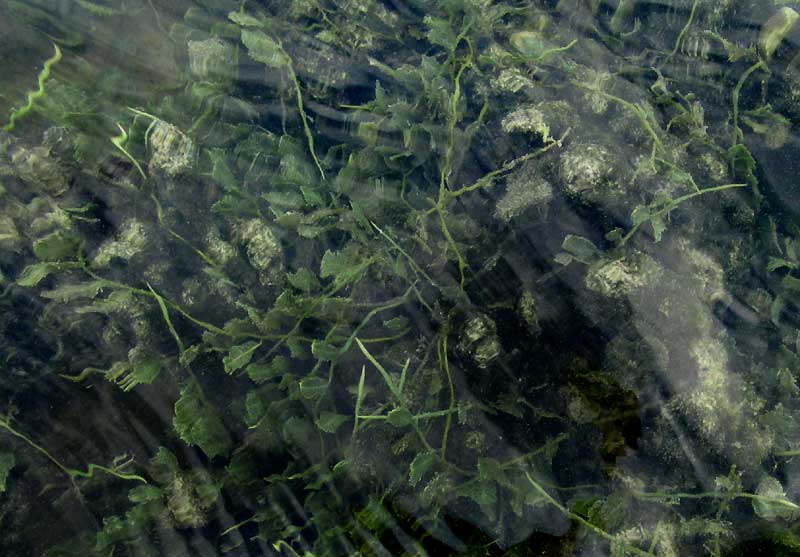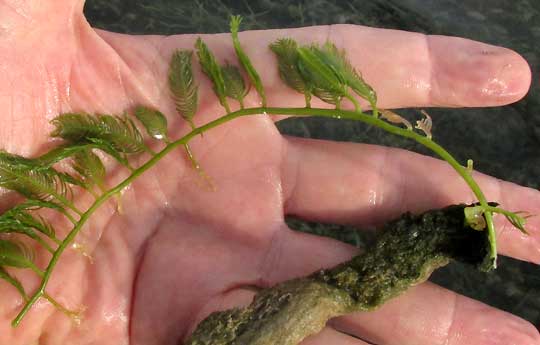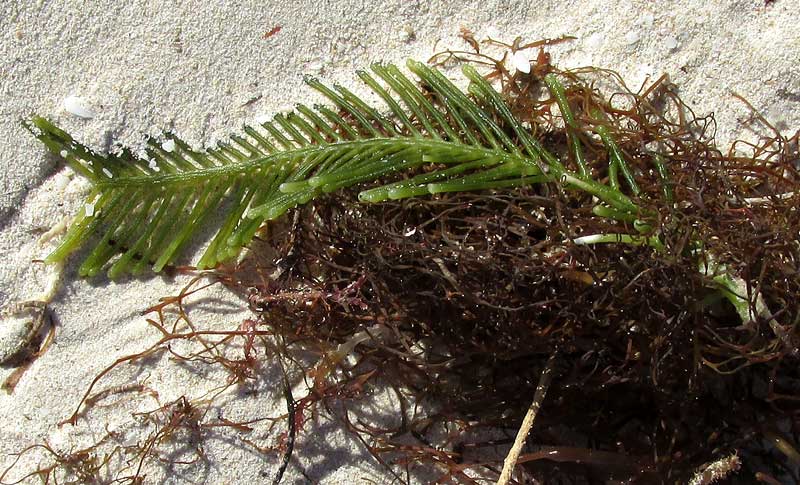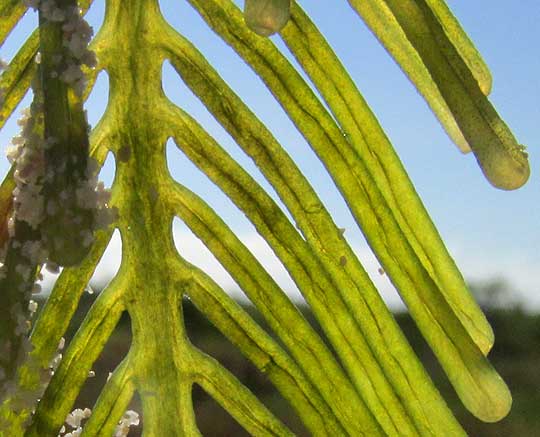Excerpts from Jim Conrad's
Naturalist Newsletter

from the November 23, 2014 Newsletter issued from Río Lagartos, on the Yucatan Peninsula's northern coast (~N21.60°, ~W88.16°), Yucatán state, MÉXICO
GREEN FEATHER ALGA
The Ría Lagartos estuary into which the town of Río Lagartos juts has large areas so shallow that a regular motorboat's motor plows into the mud if you don't tilt it up. These shallows are carpeted with thick mats of sea-grass and large algae. As the boat floats over the shallows, sometimes for unclear reasons the vegetation changes. This week a certain patch caught my eye where a stringy network of something new was creeping atop the usual alga species. Above, you can see what it looked like from the boat.
It was easy enough to reach into the water and retrieve the creeper. It's shown below:

Notice how its rootlike rhizoids penetrate the filamentous alga it was growing atop. A close-up of featherlike fronds arising from one side of the stemlike stolon, with branching rhizoids on the stolon's opposite side, is shown below:

The feathery fronds of the plant photographed in the estuary's shallows reached only about 2cm long (¾ inch) but under other growing conditions they can reach 15-20 cm (6-8 inches). Below, you can see a much larger frond washed up on sand on the ocean side of the barrier island opposite Río Lagartos:

A pretty close-up of a tiny part of that washed-up frond is shown below:

Having no technical literature dealing with algae, an Internet search was conducted looking for images tagged with the keywords "green algae feather." Soon I was led to the genus Caulerpa, species of which often are referred to as green feather algae. However, about 35 species and varieties of Caulerpa are to be found in the Caribbean and western Atlantic Ocean, and several are very similar to ours, so at first I doubted our find could be identified to species level.
However, when the Ría Lagartos Biosphere Reserve was established, teams of biologists cooperated to list organisms found in the Reserve, and they identified nine Caulerpa species. Image searches on the Internet indicate that of those nine species CAULERPA SERTULARIOIDES looks most like what's in our pictures.
That's a clumsy and risky way to identify things, but the pictures sure look right, plus among the Caulerpa species Caulerpa sertularioides is the one whose habitat description most matches where we found ours.
Caulerpa sertularioides is described as occurring in scattered populations among seagrass beds, as well as attached to prop roots of the Red Mangrove. Here the entire estuary is fringed with Red Mangrove. It prefers more shallow depths than most other Caulerpa species, mostly less than 10m deep (100ft).
Also, we're well within the known distribution area of Caulerpa sertularioides, which extends from North Carolina south along the US coast into the Gulf of Mexico and throughout the Caribbean, and the southern Atlantic in general, south to Brazil. It also pops up here and there in places like northern Mexico's Pacific Coast, Australia's Great Barrier Reef, Papua New Guinea, and other places.
Aquarium enthusiasts often grow Green Feather Alga because it's more or less palatable to certain fish, easy to care for, reproduces by fragmentation, and it's pretty. In fact, it's so robust that along the northern Pacific coast of Costa Rica it's spreading rapidly, invasively, over coral reefs. However, Green Sea Turtles eat it, as well as several species of sea slug, including Oxynoe panamensis, which feeds exclusively on it.